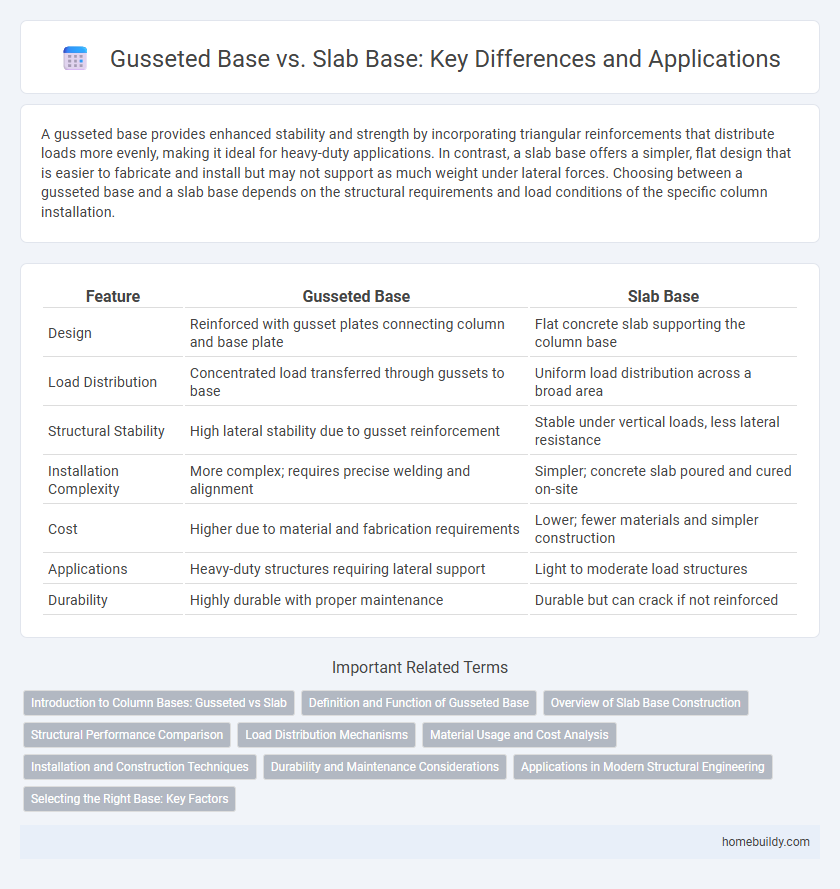A gusseted base provides enhanced stability and strength by incorporating triangular reinforcements that distribute loads more evenly, making it ideal for heavy-duty applications. In contrast, a slab base offers a simpler, flat design that is easier to fabricate and install but may not support as much weight under lateral forces. Choosing between a gusseted base and a slab base depends on the structural requirements and load conditions of the specific column installation.
Table of Comparison
| Feature | Gusseted Base | Slab Base |
|---|---|---|
| Design | Reinforced with gusset plates connecting column and base plate | Flat concrete slab supporting the column base |
| Load Distribution | Concentrated load transferred through gussets to base | Uniform load distribution across a broad area |
| Structural Stability | High lateral stability due to gusset reinforcement | Stable under vertical loads, less lateral resistance |
| Installation Complexity | More complex; requires precise welding and alignment | Simpler; concrete slab poured and cured on-site |
| Cost | Higher due to material and fabrication requirements | Lower; fewer materials and simpler construction |
| Applications | Heavy-duty structures requiring lateral support | Light to moderate load structures |
| Durability | Highly durable with proper maintenance | Durable but can crack if not reinforced |
Introduction to Column Bases: Gusseted vs Slab
Gusseted bases provide enhanced stability by integrating triangular steel plates that distribute loads efficiently at column connections, making them suitable for high-stress or seismic conditions. Slab bases consist of a flat steel plate anchored directly to the concrete foundation, offering a simpler and cost-effective solution for lighter structural loads. Selecting between gusseted and slab bases depends on load requirements, structural design, and site conditions to ensure optimal support and durability.
Definition and Function of Gusseted Base
A gusseted base is a structural steel column base plate reinforced with gusset plates that distribute loads more evenly and increase stability by connecting the base plate to the column web or flange. Unlike a slab base, which rests directly on the concrete foundation and relies primarily on anchor bolts for support, the gusseted base enhances load transfer and resists bending moments through its triangular gusset plates. This design is ideal for heavy-duty columns requiring additional reinforcement against lateral forces and moments in construction frameworks.
Overview of Slab Base Construction
Slab base construction involves a reinforced concrete footing designed to distribute column loads evenly across the ground, enhancing structural stability and load-bearing capacity. This type of base integrates a base plate anchored to the slab with bolts, providing a solid foundation ideal for heavy columns and reducing soil settlement risk. Compared to gusseted bases, slab bases offer a more uniform load transfer and are suited for infrastructure requiring substantial support over wider areas.
Structural Performance Comparison
Gusseted bases provide enhanced load distribution and increased rigidity compared to slab bases, reducing stress concentrations at the column-to-base connection. The triangular gussets improve moment resistance and lateral stability, making them ideal for structures subject to dynamic or lateral loads. Slab bases, while simpler and more cost-effective, are less effective in handling high moments and are better suited for axial load conditions with minimal lateral forces.
Load Distribution Mechanisms
Gusseted base plates enhance load distribution by incorporating triangular stiffeners that transfer stresses from the column to the foundation more effectively, reducing bending moments and shear forces. Slab bases spread axial loads uniformly across a larger surface area but may experience higher localized stress concentrations at the column-to-base interface. Understanding the load transfer paths in gusseted and slab bases is crucial for optimizing structural performance under vertical and lateral loads.
Material Usage and Cost Analysis
Gusseted bases require more steel for the additional gusset plates and welds, leading to higher material usage compared to slab bases that use a single thick steel plate. The increased complexity of gusseted bases also raises fabrication and installation costs, whereas slab bases offer simpler construction and reduced labor expenses. Cost analysis shows slab bases provide a more economical solution for medium to light load columns, while gusseted bases are preferred for heavy loads requiring enhanced stability.
Installation and Construction Techniques
Gusseted bases simplify installation by providing enhanced stability through welded gussets that distribute loads more evenly, reducing the risk of base plate bending during anchor bolt tightening. Slab bases require precise anchor bolt placement and leveling to ensure proper alignment, often necessitating grout under the base plate to achieve full bearing contact. Construction techniques for gusseted bases favor faster erection times due to fewer alignment adjustments, while slab bases demand careful surface preparation and curing time for the concrete foundation.
Durability and Maintenance Considerations
A gusseted base enhances column stability by distributing loads through triangular steel plates, reducing stress concentrations and increasing durability in dynamic or heavy-load environments. Slab bases provide a simpler connection but may require more frequent inspections and maintenance to address potential cracking and corrosion at weld joints. Choosing a gusseted base improves long-term structural integrity and lowers maintenance costs compared to slab bases, which are more susceptible to wear under fluctuating loads.
Applications in Modern Structural Engineering
Gusseted bases offer enhanced load distribution and moment resistance, making them ideal for high-rise steel frameworks and seismic design applications. Slab bases, favored for their simplicity and cost-effectiveness, are commonly used in low-rise buildings and light industrial structures where bending moments are minimal. Modern structural engineering often selects gusseted bases for dynamic load conditions, while slab bases suit static load scenarios with straightforward connections.
Selecting the Right Base: Key Factors
Selecting the right column base involves assessing load capacity, installation environment, and structural requirements. Gusseted bases provide enhanced lateral stability through diagonal bracing, making them ideal for high-wind or seismic areas. Slab bases offer simplicity and ease of installation, suitable for moderate loads and non-critical applications where cost-effectiveness is a priority.
gusseted base vs slab base Infographic

 homebuildy.com
homebuildy.com